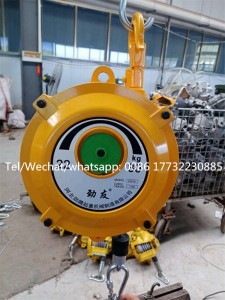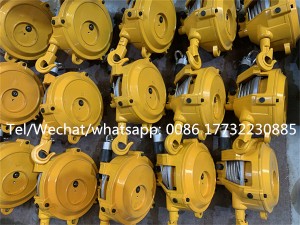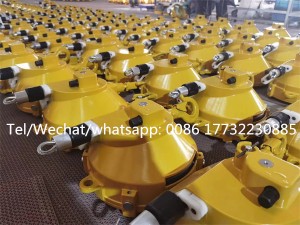A spring balancer, also known as a tool balancer or load balancer, is a mechanical device used to support and balance the weight of tools, equipment, or loads in various industrial applications. It employs the use of a spring mechanism to offset the weight, making it easier to handle and manipulate heavy objects. Here are some key features and information about spring balancers:
Design and Components: A spring balancer typically consists of a housing or casing that encloses a coiled spring. The spring is connected to a cable or wire rope, which is further attached to the load or tool to be balanced. The housing contains an adjustable tension mechanism that allows the user to set the desired balance or tension based on the weight of the load.
Load Balancing: The primary function of a spring balancer is to offset the weight of a load, reducing the effort required to lift, lower, or suspend it. The tension of the spring can be adjusted to match the weight of the load, creating a near-neutral or balanced condition. This allows the load to be positioned at a desired height or moved with minimal effort.
Range and Capacity: Spring balancers come in various sizes and weight capacities to accommodate different load requirements. The capacity typically ranges from a few kilograms to several hundred kilograms or more. It is important to select a spring balancer with a capacity that matches or exceeds the weight of the load being supported.
Suspension Options: Spring balancers are available in different suspension configurations to suit different applications. Common suspension options include a hook for attaching the load directly, a bracket or mounting plate for attaching tools or equipment, or a combination of both. Some spring balancers also feature a safety mechanism, such as a safety rope or secondary suspension point, to prevent accidental release of the load in case of spring failure.
Application Areas: Spring balancers find applications in various industries such as manufacturing, assembly lines, automotive, construction, and maintenance. They are commonly used for tasks such as suspending power tools, pneumatic tools, welding guns, spray guns, lighting fixtures, and other equipment that require frequent use or positioning at varying heights.
Safety Considerations: While using spring balancers, it is important to consider safety precautions:
Ensure that the spring balancer is properly matched to the weight of the load being supported.
Regularly inspect the spring balancer for wear, damage, or any signs of malfunction. Replace or repair any defective components.
Follow the manufacturer’s instructions for proper installation, adjustment, and usage of the spring balancer.
Be aware of the load’s movement and potential swing during operation. Take precautions to prevent collisions or accidents caused by swinging loads.
Avoid exceeding the recommended load capacity or overextending the spring balancer, as it may lead to premature failure or loss of balance.
Spring balancers are valuable tools that enhance ergonomics, improve productivity, and reduce operator fatigue by providing a counterbalance for suspended loads. By utilizing spring technology, they offer a cost-effective solution for handling heavy objects safely and efficiently.
Post time: Aug-29-2023








